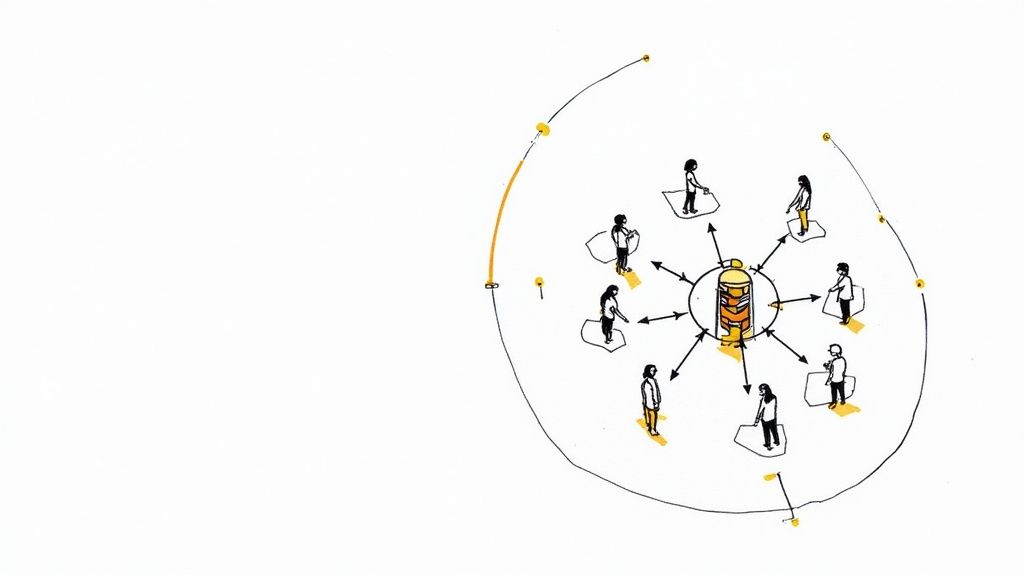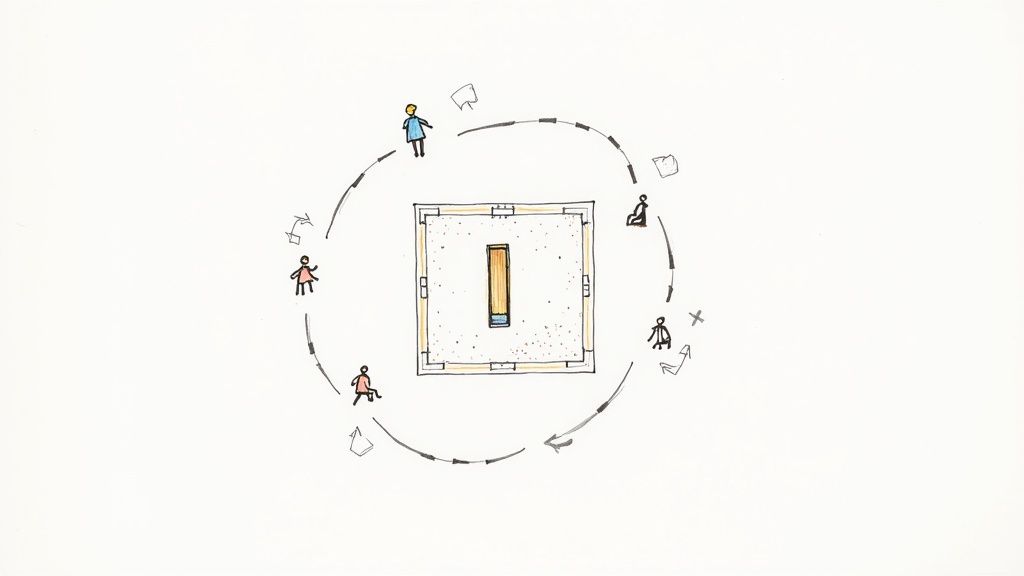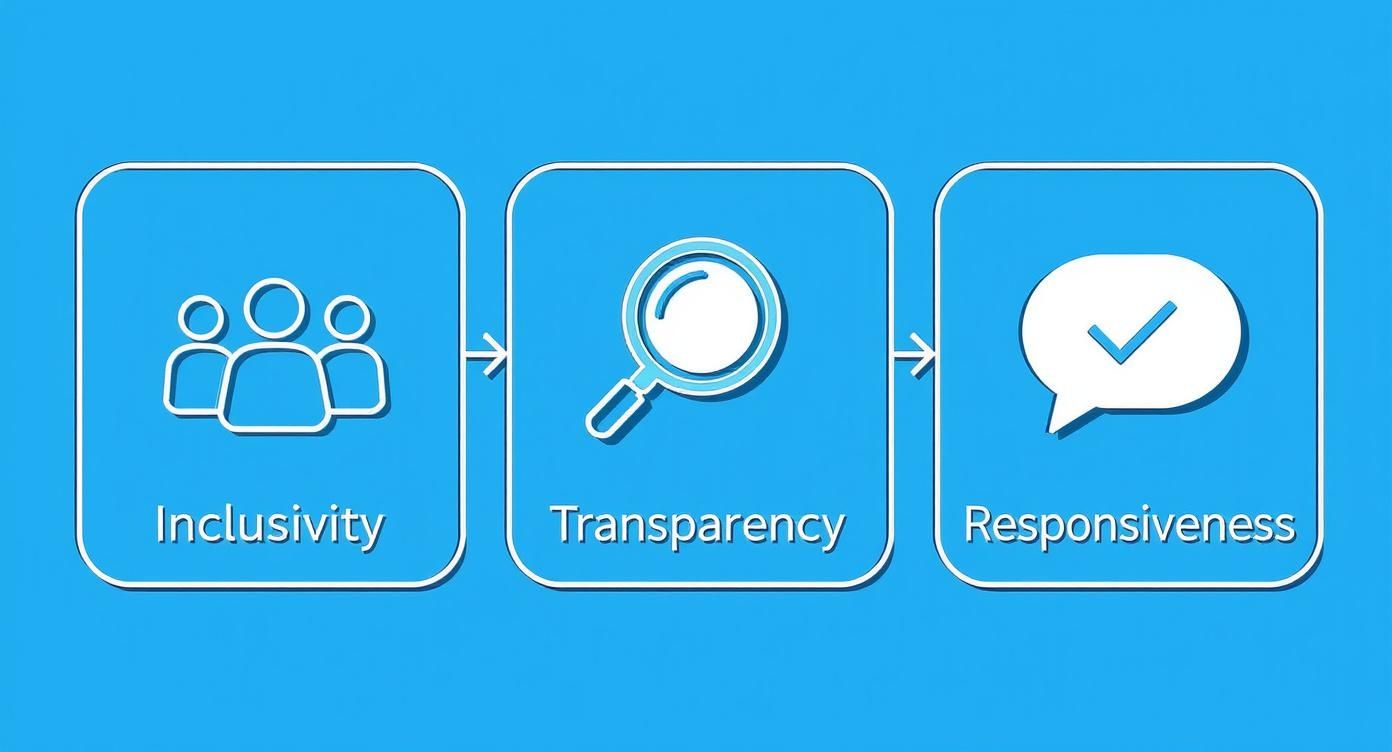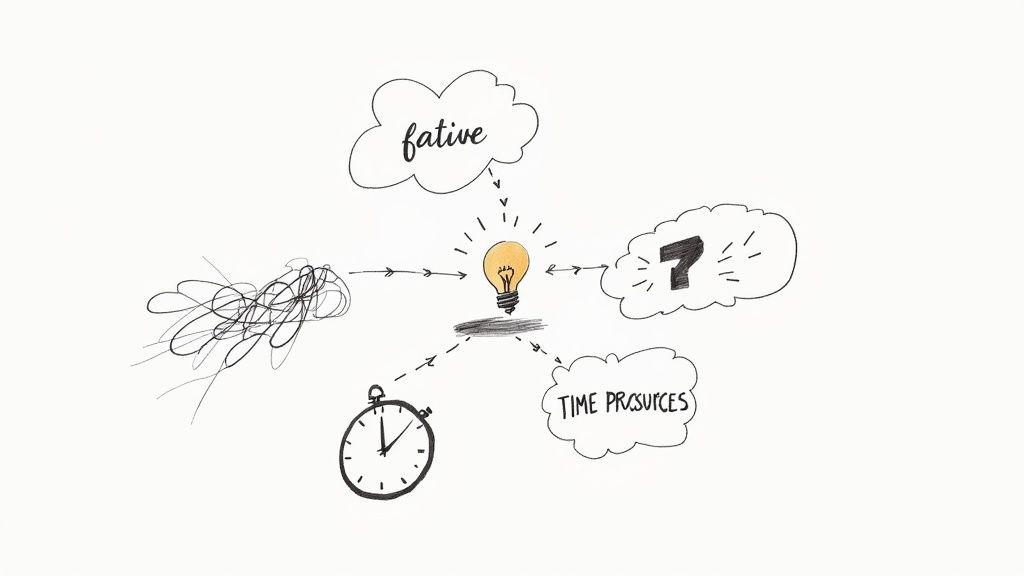October 23, 2025

Think of it this way: you wouldn't build a playground without asking kids what they actually want to play on, right? That’s stakeholder engagement in a nutshell. It’s the art of building real, two-way relationships with anyone who has a vested interest in what you're doing.
This isn't just about sending out newsletters or one-way updates. It’s a genuine dialogue—a process of listening, collaborating, and making sure everyone involved feels seen, heard, and valued.
At its heart, stakeholder engagement is about realizing that success is a team sport. It shifts the dynamic from simply managing people to treating their input as a valuable asset. A stakeholder can be anyone with an interest in your organization's actions, from your own team members and investors to your customers and the local community.
The real goal is to get your project's objectives in sync with their needs and expectations, which builds a powerful sense of shared ownership. This is a continuous cycle of interaction that builds trust and helps you spot potential risks before they become major problems.
For example, a software company that regularly checks in with its users while building a new feature is practicing great stakeholder engagement. They can catch design flaws early, add features people will actually use, and create a community of loyal fans who feel like they're part of the journey.

Figuring out who your stakeholders are is always the first step. They typically fall into two main camps:
To help you get a clearer picture, let's break down some common stakeholder groups and what they typically care about.
A quick look at common stakeholder types and what matters most to them in relation to an organization.
Understanding these different perspectives is crucial for creating an engagement strategy that resonates with each group and addresses their specific concerns.
Technology has completely changed how we connect with these groups. Today, digital tools are a must-have for clear and effective communication. In fact, a whopping 85% of organizations report using at least one digital tool for stakeholder engagement, a huge jump from just 42% in 2019. This move to digital allows for smarter, more focused conversations, which ultimately leads to better results for everyone. For more on this trend, you can find some great insights on the future of stakeholder engagement on Quicker.com.au.
Knowing what stakeholder engagement is is one thing. Understanding its power as a strategic advantage is something else entirely. It’s not just another box to check on a project plan; it’s what turns a good idea into a collaborative success.
Think of it like this: proactive engagement is the difference between trying to navigate a dense forest by guessing and heading out with a detailed map and compass. You're not just hoping to find your way; you're actively plotting the best course.
When you bring stakeholders into the fold early and often, you tap into a rich vein of expertise and fresh perspectives. This collaboration acts as an early warning system, helping you spot potential risks and roadblocks before they turn into expensive, time-consuming disasters. They see the blind spots you can't.
By aligning stakeholders with their respective roles and responsibilities, organizations can create a framework for stakeholder engagement that is both effective and efficient. This helps identify potential areas of conflict, allowing organizations to address these issues before they become major problems.
Imagine a tech company is getting ready to launch a new app. The old way was to build it in a silo and hope people liked it. The smart way? They bring in a diverse group of beta testers—a key group of external stakeholders—from the very beginning.
This proactive approach means they get critical user feedback, squash bugs, and add features people are genuinely excited about before the launch. The final product is stronger, and they've already built a loyal user base that feels heard and valued.
That whole process builds the most valuable currency in business: trust. When your stakeholders know their voice matters, they’re far more likely to champion your work, especially when things get tough. To see how this plays out, check out the core benefits of community engagement which are foundational to building that trust.
At the end of the day, this open dialogue strengthens every relationship connected to your organization. To get a handle on creating a unified experience, it's worth exploring strategies for mastering omni-channel customer engagement and building loyalty that lasts.
When everyone from your internal team to your end-users feels genuinely involved, they become more than just stakeholders—they become advocates. This collective buy-in is what fuels not just immediate project success, but also long-term, sustainable growth.
Getting stakeholder engagement right isn't an accident. It's a deliberate process built on a few core principles. You can think of it like a three-legged stool—take away any one of the legs, and the whole thing topples over.
Those three legs are Inclusivity, Transparency, and Responsiveness. Nailing these is the difference between engagement that actually works and engagement that's just for show.
The first pillar, inclusivity, is all about making sure you hear from everyone who has a stake in the outcome, not just the loudest or easiest voices to reach. It means you have to actively seek out different perspectives, especially from groups that might otherwise be overlooked or hesitant to come forward.
When you do this, your decisions become far more robust because they account for a much wider range of impacts. A great example is a city council planning a new park. If they only listen to wealthy homeowners, they'll miss the needs of renters, families with young kids, or seniors. Being inclusive means they would send out meeting notices in multiple languages and even offer childcare during forums, removing barriers so more of the community can actually show up and be heard.
Next up is transparency. This one is simple in theory but can be tough in practice: be open and honest in your communication. It’s about sharing information clearly, even when it’s not all good news.
Transparency is the bedrock of trust, and trust is the currency of any healthy professional relationship. A company that puts out an annual social impact report—detailing both its sustainability wins and where it fell short—is putting transparency into action. That kind of honesty shows you respect your stakeholders and builds incredible credibility.
"By aligning stakeholders with their respective roles and responsibilities, organizations can create a framework for stakeholder engagement that is both effective and efficient."
Of course, you can't get that alignment without a clear, transparent flow of information.
Finally, we have responsiveness. This is the pillar that proves you were actually listening. It’s not enough to just collect feedback; you have to show people that their input was heard, considered, and, when possible, acted on.
This "closing the loop" is what makes people feel valued and encourages them to participate again in the future. It requires having a solid process for tracking and addressing feedback, which is often a key task for anyone in a community manager role.
The impact is huge. Globally, when businesses and the public are actively involved in shaping regulations, compliance can jump by 15-20%. You can dig into the OECD's findings on stakeholder engagement to see the data for yourself. Why? Because responsiveness makes people feel like true partners in the process, not just spectators.
Putting theory into practice means having a clear, actionable plan. A solid framework for stakeholder engagement is your roadmap, making sure every voice that matters is heard. Think of it like planning a successful event: every stage, from the guest list to the follow-up, is critical for a great outcome.
The process isn't rocket science. It really boils down to four logical steps. You start by figuring out who to invite (identifying stakeholders), then you set the agenda and send the invites (planning), host the party (active engagement), and finally, send out the thank-you notes and ask for feedback (evaluation).
First things first, you need to know who's coming to the party. This initial step is all about brainstorming every single person, group, or organization that has a stake in your project's success or could be affected by it. This is a core part of any good community engagement strategy.
Once you have your list, it's time to map them out. A go-to tool for this is the power/interest grid, which helps you sort stakeholders based on their level of influence and how invested they are. This simple visualization is a game-changer for prioritizing your efforts—it shows you who needs your full attention versus who just needs a quick update now and then.
With your "guest list" sorted, it's time to plan the main event. This stage is about setting clear goals for your engagement. What are you actually trying to accomplish? Are you looking for honest feedback, trying to get everyone on the same page, or just sharing important information?
Your goals will dictate which methods you use. You might host a big town hall meeting, run a focused workshop, or opt for one-on-one interviews, surveys, or an online forum. To get past the surface-level chatter and really understand what people think, your plan should include a strategic guide for deep insights using open-ended questions.
This infographic breaks down the core ideas that should steer every part of your engagement plan.

At the end of the day, building your efforts on a foundation of inclusivity, transparency, and responsiveness is what creates real trust and collaboration.
Picking the right communication channel is crucial. A survey might be great for gathering broad opinions, but a workshop is better for digging into complex problems collaboratively.
Here’s a quick comparison to help you match the method to your goals.
The key is to use a mix of methods. This ensures you're not just hearing from the loudest voices but are capturing a wide range of perspectives.
Now it's showtime. This is where the actual conversations happen. Your job is to foster open, honest, and respectful two-way dialogue. Make sure you’re actively listening and creating a space where everyone feels comfortable enough to share what's on their mind.
But the work isn't over when the event ends. The final—and most important—step is to evaluate what you learned and report back. After the engagement, comb through the feedback and data you've collected. Then, close the loop by letting stakeholders know how their input was used and what decisions came from it. This simple act shows their contribution was valued and makes them far more likely to participate again.
Let's be honest: even with the best intentions, stakeholder engagement rarely goes off without a hitch. You can have a perfect plan, but real-world dynamics have a way of throwing curveballs. The trick isn't to avoid these problems entirely—it's to see them coming and know how to handle them.
One of the most common issues I've seen is stakeholder fatigue. It's that familiar feeling when people get tired of being asked for their opinion, especially when they feel like their input vanishes into a black hole. Participation dwindles, and enthusiasm dies. The fix? Always "close the feedback loop." Make a point to show people exactly how their contributions made a difference in the final decision.

Things get really interesting when different groups have competing priorities. Imagine investors pushing to cut costs while your team is begging for better resources. It's a classic tug-of-war. Your job isn't to pick a winner but to get everyone pulling in the same general direction.
A few proven facilitation techniques can help you find that common ground:
Nailing these conversations does more than just solve a problem; it shows you're a leader who can navigate complex human dynamics.
Stakeholder engagement is now a huge part of social responsibility, with 75% of leaders calling it a top priority. And while 80% agree that face-to-face dialogue is the best way to do it, less than 40% of experts feel current methods actually work. That’s a massive gap between talk and results. You can discover more about building stakeholder trust in recent findings from Globescan.
Finally, there’s the challenge of getting leadership on board, especially when budgets are tight. Don't just ask for their support; build a solid business case for it. Use hard data to show how investing in engagement now will prevent costly problems, reduce project risks, and lead to better outcomes down the road. By tracking the right community engagement metrics, you can prove the ROI and make it an easy "yes."
As you start to focus more on stakeholder engagement, a few questions are bound to pop up. Let's tackle some of the most common ones to help you build a solid strategy from the get-go.
Start by brainstorming every single person, group, or company that could be impacted by your work, have some sway over it, or simply care about the outcome. It helps to sort them into big buckets like internal (your team, managers, board members) and external (customers, suppliers, local community leaders).
Once you have your list, the real magic is in creating a stakeholder map. This is a simple visual that lets you plot everyone based on how much influence they have and how interested they are. Doing this makes it crystal clear where you need to focus your energy first.
It's a common mix-up, but they represent two very different ways of thinking. Stakeholder management is often more one-directional—it's about controlling risks and steering people toward a goal you've already set. Think of it like directing traffic to keep things moving smoothly.
Stakeholder engagement, on the other hand, is all about collaboration and building real relationships. It’s a two-way street focused on creating genuine partnerships and finding shared value. Instead of directing traffic, you're building a bridge together.
The real shift happens when you move from a "management" mindset, which can feel transactional, to a collaborative one. This change builds mutual respect and a sense of shared ownership, which almost always leads to better, more lasting results.
You'll measure success with a mix of hard data and human feedback. The numbers are a great place to start—track things like survey response rates, how many people show up to your events, or even a drop in negative social media mentions. These metrics give you a tangible look at participation.
But don't stop there. The qualitative side is just as important. Collect feedback through surveys, listen for personal stories and testimonials, and pay attention to the general vibe of the conversations you're having. At the end of the day, success looks like better project outcomes, stronger relationships, and a real increase in trust all around.
Ready to put this all into practice? GroupOS is the all-in-one platform designed to help you manage your professional network, run seamless events, and build a vibrant community. Find out how it can work for you at https://groupos.com.


